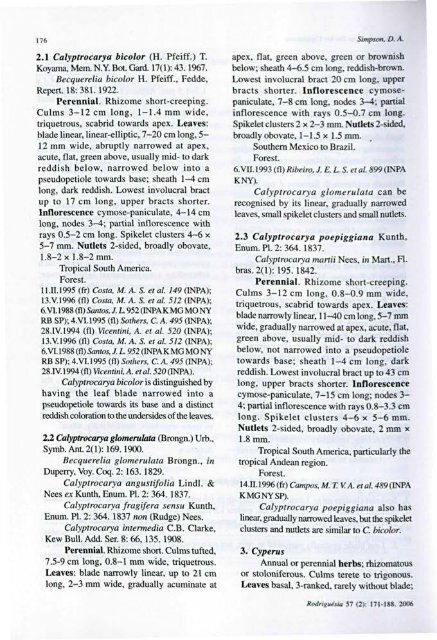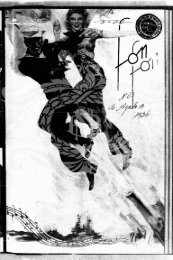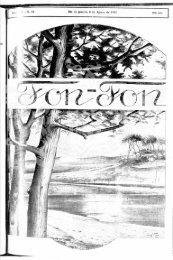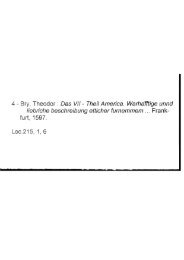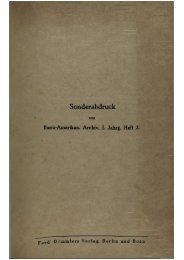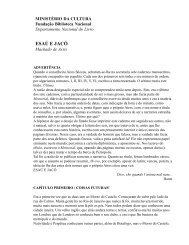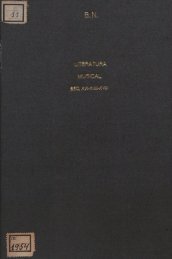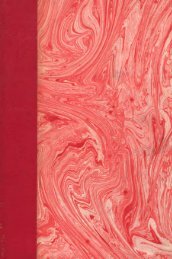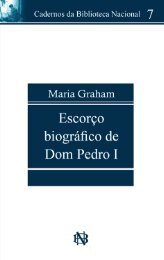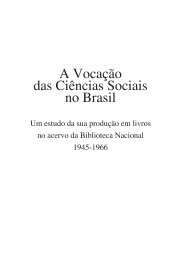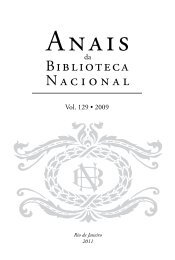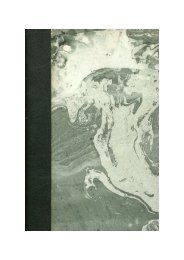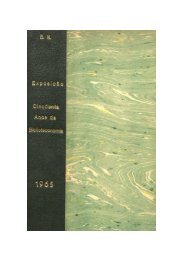RODRIGUESIA Revista do Jardim Botânico do Rio de Janeiro
RODRIGUESIA Revista do Jardim Botânico do Rio de Janeiro
RODRIGUESIA Revista do Jardim Botânico do Rio de Janeiro
Create successful ePaper yourself
Turn your PDF publications into a flip-book with our unique Google optimized e-Paper software.
176<br />
2.1 Calyptrocarya bicolor (H. Pfeiff.) T.<br />
Koyama, Mem. N.Y. Bot. Gard. 17(1): 43. 1967.<br />
Becquerelia bicolor H. Pfeiff., Fed<strong>de</strong>,<br />
Repert. 18:381. 1922.<br />
Perennial. Rhizome short-creeping.<br />
Culms 3-12 cm long, 1-1.4 mm wi<strong>de</strong>,<br />
triquetrous, scabrid towards apex. Leaves:<br />
bla<strong>de</strong> linear, linear-elliptic, 7-20 cm long, 5-<br />
12 mm wi<strong>de</strong>, abruptly narrowed at apex,<br />
acute, flat, green above, usually mid- to dark<br />
reddish below, narrowed below into a<br />
pseu<strong>do</strong>petiole towards base; sheath 1-4 cm<br />
long, dark reddish. Lowest involucral bract<br />
up to 17 cm long, upper bracts shorter.<br />
Inflorescence cymose-paniculate, 4-14 cm<br />
long, no<strong>de</strong>s 3-4; partial inflorescence with<br />
rays 0.5-2 cm long. Spikelet clusters 4-6 x<br />
5-7 mm. Nutlets 2-si<strong>de</strong>d, broadly obovate,<br />
1.8-2 x 1.8-2 mm.<br />
Tropical South America.<br />
Forest.<br />
11.11.1995 (fr) Costa, M. A. S. et ai. 149 (INPA);<br />
13.V.1996 (fl) Costa, M. A. S. et ai. 512 (INPA);<br />
6.VI. 1988 (fl) Santos, J. L 952 (INPA K MG MO NY<br />
RB SP); 4.VI. 1995 (fl) Sothers, C. A. 495 (INPA);<br />
28.IV. 1994 (fl) Vicentini, A. et ai. 520 (INPA);<br />
13.V.1996 (fl) Costa, M. A. S. et ai. 512 (INPA);<br />
6.VI. 1988 (fl) Santos, J. L 952 (INPA K MG MO NY<br />
RB SP); 4.VI. 1995 (fl) Sothers, C. A. 495 (INPA);<br />
28.1 V. 1994 (fl) Vicentini, A. et ai. 520 (INPA).<br />
Calyptrocarya bicolor is distinguished by<br />
having the leaf bla<strong>de</strong> narrowed into a<br />
pseu<strong>do</strong>petiole towards its base and a distinct<br />
reddish coloration to the un<strong>de</strong>rsi<strong>de</strong>s of the leaves.<br />
2.2 Calyptrocarya glomeruUUa (Brongn.) Urb.,<br />
Symb.Ant.2(l): 169.1900.<br />
Becquerelia glomerulata Brongn., in<br />
Duperry, Voy. Coq. 2: 163. 1829.<br />
Calyptrocarya angustifolia Lindl. &<br />
Nees ex Kunth, Enum. PI. 2: 364. 1837.<br />
Calyptrocarya fragifera sensu Kunth,<br />
Enum. PI. 2: 364. 1837 non (Rudge) Nees.<br />
Calyptrocarya intermedia C.B. Clarke,<br />
Kew Buli. Add. Ser. 8: 66, 135. 1908.<br />
Perennial. Rhizome short. Culms tufted,<br />
7.5-9 cm long, 0.8-1 mm wi<strong>de</strong>, triquetrous.<br />
Leaves: bla<strong>de</strong> narrowly linear, up to 21 cm<br />
long, 2-3 mm wi<strong>de</strong>, gradually acuminate at<br />
Simpson, D. A.<br />
apex, flat, green above, green or brownísh<br />
below; sheath 4-6.5 cm long, reddish-brown.<br />
Lowest involucral bract 20 cm long, upper<br />
bracts shorter. Inflorescence cymosepaniculate,<br />
7-8 cm long, no<strong>de</strong>s ?>-A; partial<br />
inflorescence with rays 0.5-0.7 cm long.<br />
Spikelet clusters 2 x 2-3 mm. Nutlets 2-si<strong>de</strong>d,<br />
broadly obovate, 1-1.5 x 1.5 mm.<br />
Southern México to Brazil.<br />
Forest.<br />
6. VII. 1993 (fl) Ribeiro, J. E. L. S. et ai. 899 (INPA<br />
KNY).<br />
Calyptrocarya glomerulata can be<br />
recognised by its linear, gradually narrowed<br />
leaves, small spikelet clusters and small nutlets.<br />
2.3 Calyptrocarya poepiggiana Kunth,<br />
Enum. PI. 2: 364. 1837.<br />
Calyptrocarya martii Nees, in Mart., Fl.<br />
bras.2(l): 195. 1842.<br />
Perennial. Rhizome short-creeping.<br />
Culms 3-12 cm long, 0.8-0.9 mm wi<strong>de</strong>,<br />
triquetrous, scabrid towards apex. Leaves:<br />
bla<strong>de</strong> narrowly linear, 11-40 cm long, 5-7 mm<br />
wi<strong>de</strong>, gradually narrowed at apex, acute, flat,<br />
green above, usually mid- to dark reddish<br />
below, not narrowed into a pseu<strong>do</strong>petiole<br />
towards base; sheath 1-4 cm long, dark<br />
reddish. Lowest involucral bract up to 43 cm<br />
long, upper bracts shorter. Inflorescence<br />
cymose-paniculate, 7-15 cm long; no<strong>de</strong>s 3-<br />
4; partial inflorescence with rays 0.8-3.3 cm<br />
long. Spikelet clusters 4-6 x 5-6 mm.<br />
Nutlets 2-si<strong>de</strong>d, broadly obovate, 2 mm x<br />
1.8 mm.<br />
Tropical South America, particularly the<br />
tropical An<strong>de</strong>an region.<br />
Forest.<br />
14.11.1996 (fr) Campos, M.T.VA.et ai. 489 (INPA<br />
KMGNYSP).<br />
Calyptrocarya poepiggiana also has<br />
linear, gradually narrowed leaves, but the spikelet<br />
clusters and nutlets are similar to C. bicolor.<br />
3. Cyperus<br />
Annual or perennial herbs; rhizomatous<br />
or stoloniferous. Culms terete to trigonous.<br />
Leaves basal, 3-ranked. rarely without bla<strong>de</strong>;<br />
Rodriguésia 57 (2): 171-188. 2006


